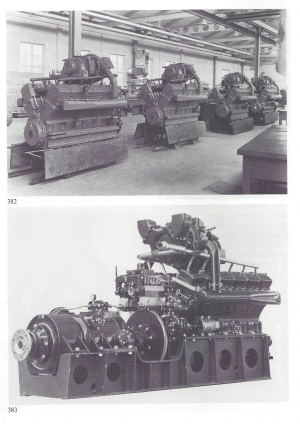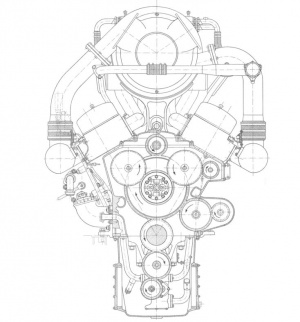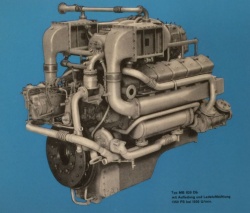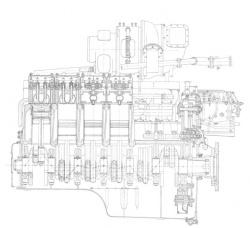MB 820
Marine og industrimotor, V12 med ca 60 liter slagvolum.
Benyttet som fremdriftsmotor i hurtigbåter, ubåter (Kobben-klassen).
MB 820
Ble med inn i mtus sortiment som mtu serie 493
-- MTZ Nr. 4 Juli/August 1950 DK 621.431.72
Fra Overingeniør Otto Schilling, Stuttgart-Untertürkheim ---
The new 800-hp Daimler-Benz railcar diesel engine with mechanical powered charger or exhaust charging.
Daimler-Benz Aktiengesellschaft, as the oldest factory for high-speed internal combustion engines, has always kept up with the development of railcars by creating suitable drive motors. However, while the preference was given to low-speed engines elsewhere, the aim here was to quickly build running machines for this purpose.
It was recognized early on that the fast-running engine has extraordinary advantages in terms of its weight and its installation dimensions, and that only with it is it possible to accommodate greater performance in the available space in the vehicle.
Of course, special efforts were needed to achieve the reliability and long life, which are particularly important for railcars, in spite of the fastness. These very aspects have always been decisive in the design and choice of building materials for this type of engine. These principles have succeeded not only in achieving the usual lifespan of slower engines, but also in significantly increasing them.
Recently, the Daimler-Benz AG has a 800-horsepower diesel motor to be reported here. It is the logical further development of the 450-hp MB 806 diesel engine built before the war and tested in many kilometres. (Picture 1.)
As with him in particular the experience was collected, which are the rough railway operation, he should be briefly mentioned here again, although he has been briefly described in the context of a larger essay (Bushman, railcar engines, MTZ 1940, Issue 5)
The MB 806 was built as a 12-cylinder V engine, initially without charging and made on the brake about 650 hp at n = 1400 rpm. Since the vehicles in which it was installed required only 450 hp, this resulted in a considerable power reserve, which was very expedient for railcars with regard to achieving the longest possible service life of the engine.
With these engines running times of 150 000 km and more until the first major overhaul he enough, which in terms of the type of vehicles concerned (it was express railcar) an operating time of about 3000 hours equals. The installation of the engine in a bogie of the company Westwaggon in Cologne, coupled with a generator of the company BBC Mannheim, shows Figure 2. Shortly before the war, this engine is already with Aufla - tion, by a turbocharger vertical design (Type Büchi), built. With charging, the power was about 750 hp at n = 1400 rpm. The thermal load corresponded approximately to that of 450 hp at the uncharged engine.
The installation in a vehicle was in this engine, which is also described in the above-mentioned essay, unfortunately no longer possible because of the outbreak of war. A promising development would have to be stopped by a war.
After the war, the development of this engine was immediately resumed, despite the difficulties caused by the almost complete destruction of the factory. All facilities, models etc. were lost. Therefore, a completely new model had to be developed in which, however, one could evaluate the rich operational experience which had resulted in the pre-war railcar engines for the new machines.
Likewise, the manifold fabrication and design experiences were taken into account, which could be acquired in all areas of large engine construction true to the end of the war. Many insights, in particular the choice of suitable materials, surface refinement, etc., could be taken during the development of the persons and truck engines simultaneously being manufactured in other departments of the plant. The Federal Railways, for which the new railcar engines are primarily intended and with which mainly due to the installation collar also always close contact was required for the new railcars a much higher performance. Therefore, the total stroke volume was increased from 50 to 57.2 liters and the maximum power set to N = 800 hp with charging at n = 1400 rpm.
The new diesel engine MB 820 also has 12 cylinders in V-arrangement. He has 172 mm bore at 205 mm stroke. For the purposes of the Federal Railroad, he will also be equipped again with an exhaust charging group. It can also be delivered with mechanically driven loader. This design also shows great advantages and has proven very well in the built during the war large marine engines and aircraft engines.
In particular, for an operation with rapidly changing load, the mechanically driven supercharger is very suitable, because it follows sudden changes in load inevitably immediately and always provides a sufficient amount of air for combustion available. In the case of the exhaust gas charger, a rapid transition to a higher load requires a greater amount of exhaust gas to be produced in order to accelerate the supercharger wheel coupled to the exhaust turbine to the required supercharger speed. In this period, which may take 15-25 seconds, the diesel engine operates under air deficiency.
However, the mechanical supercharger, whose speed is chosen so that the required amount of air corresponds to the maximum power, requires too much air when moving to low load, but this is less unfavorable to the engine than working under air deficiency. Although the power required to drive the mechanical supercharger must be additionally applied by the working piston, on the other hand, there is a backflow of the exhaust gases to the piston in the exhaust gas turbine, which also costs power and additionally warms the cylinder charge with fresh air and therefore reduces it. Detailed comparative tests have shown that when the mechanical supercharger is designed for an air throughput which gives approximately the same excess air ratio for the amount of air participating in the combustion as for the exhaust gas charger, the fuel consumption differs only insignificantly. The difference after tests was about 5% at full load and n = 1400 rpm and 3% at part load and n = 1000 rpm. At lower speeds, the difference is even lower. On average, which probably corresponds to the practical operation most, ie about 4% (Figure 7).
Therefore, if the mechanically driven supercharger also has an insignificantly higher fuel consumption, then there are other benefits: The exhaust back pressure is lower, as well as the exhaust temperature almost over the entire work area, since the slightly higher compression pressures cause excellent flushing. Only at higher speeds outweighs the exhaust temperature of mechanical supercharger et what due to the influence of increasing load capacity.
Other advantages are the low weight of the mechanically driven supercharger, which weighs only about 50 kg, compared to the current weight of the exhaust gas charger of about 300 kg; then the smaller space requirement and the complete freedom of the loader of heat loads by exhaust gases. In contrast, the exhaust gas charger has the advantage that it acts silencing and a special muffler can be omitted in most cases. Both the mechanically driven supercharger and the exhaust pipe have been tested on the engine in several endurance races. Both will be well preserved if used where appropriate for their particularity. Fig. 3 shows the engine with mechanically driven loader and Fig. 4 with the system Büchi from the company BBC Mannheim.



